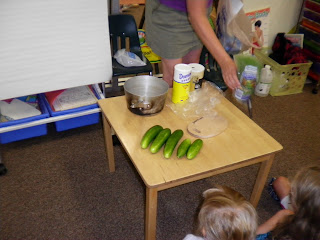This week we also had the Scholastic Book Fair, so it was impossible to plan story times, as every kid wanted me to read their new books to the class, which is great! One of the books was about a girl that goes to an orchard to pick apples. The book talked about different types of apples and the kids really seemed interested in these. As I told them that 'Granny Smith' apples are more sour or tart, a child asked, "What does sour mean?" Finding it hard to describe, other than making a puckered up face, I promised the kids we would have an apple tasting.
The next day I picked out 4 types of apples from the store. Recalling my days as a server in fine dining, I had to indulge my 'expertise' in this category, creating a 'tasting' sheet for each child.
We discussed how each one looked and smelled. We talked about texture, and how each person may prefer different tastes and textures. We explored words such as tart, sour, grainy, crisp, juicy, and sweet. The kids were tortured as I wouldn't let them taste until we talked about this, lol. :) The same feeling I had back in my own wine tasting/education days!
After each child tasted, they got to color in the apple outline with the color of their favorite apple.
These charts are great to introduce kids to pre-reading skills as well as math skills. Notice how this child finds his name and is pointing at the correct apple to color. When finished we read together each sentence. The repetitive words help the kids gain comfort and confidence in reading, become familiar with words, colors, and symbols. This is also a great assessment tool, as I am able to track a child's ability to find their own name, identify colors, etc.
The next day a student brought apples from an orchard he had picked with his family. What a great learning experience he got to have with them! A fellow teacher had an apple peeler/corer that she had just used with her class. This is key here: ALWAYS be respectful and courteous with coworkers...at the minimum! You never know when they may have something helpful or useful on hand! :)
I typically crop out my student's faces but sometimes words don't compare to their facial expressions! ( In case you're curious, parents do sign a waiver upon enrolling in our program concerning pictures anyway.)
These kind of hand-on opportunities are irreplaceable to me. They are working on fine and gross motor skills, experiencing technology (other than smart phone apps, computers, tv, etc), and feel a sense of accomplishment. I am not saying that I have an issue with kids and computers, I don't at all. Even I was amazed at the simplicity and practicality of this kitchen 'tool.'
 |
| How cool is that?! A spiral apple slice! |
No electricity needed! We were able to take the lesson outside, enjoy the fall weather, make a mess, and allow the other kids to play until their turn. A lovely way to spend our Friday afternoon. :)
I would like to say that we were able to bake an awesome apple pie with these apples, but given it was Friday afternoon and the fact that the kids were begging to try the peeled apple 'spirals,' this was were our lesson ended.
Other exciting things, we planted 'carnival carrot' seeds in this terrarium type thing. It is really cool. It is clear, on wheels, has a drain/plug, and has a lid for when the cold weather comes around.
My hopes are that we can see the carrots growing down into the soil. They grow in variety of colors too, purple, white, yellow, red, and orange! Many lessons and predictions can be done with this! Interesting fact, originally all carrots were purple! As our soil's chemical make-up has changed over time (no doubt due to civilization) whatever was in the soil that made carrots purple has depleted, causing them to be orange...sorry for the lack of scientific explanation. This is another benefit of teaching Pre-K, lol. I can tell them in basic terms...the important lesson in this, IMO, is that our presence on earth has an impact in many ways.
We have cleared and replanted fall veggies in the garden as well. An AWESOME parent has volunteered to build a removable greenhouse type thing, referred to in the gardening world as a 'hoop house'! This is a relatively easy and inexpensive project, simply requiring PVC pipe, clear plastic sheeting, clips, and stakes. Our hope is that this will enable us to extend our growing season until our pre-k family Thanksgiving celebration. We hope to harvest and prepare food from our garden, just as the Native Americans and Pilgrims did!

































